Mystère Concept IA 11
Designed in Holland but built in China, the
Mystère IA 11 is an interesting design whose chassis is finished entirely in a
high gloss black. Even the valve cover (not shown here) is painted to match,
and looks like a properly considered part of the design rather than a clumsy
add-on, but it does get very hot after a few hours of use!
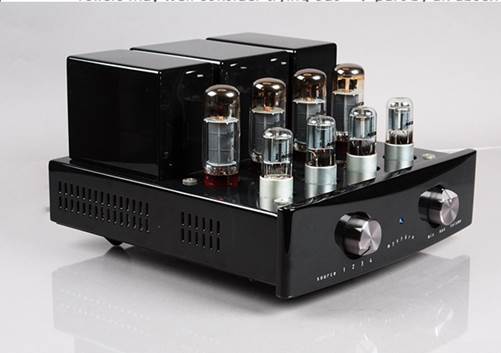
A
solidly-built and purposeful design finished in a luxurious gloss piano black.
Tried-and-tested EL34s provide the power
The circuit uses two 6SN7 double triode
valves per channel in its input stages, which drive a push-pull pair of EL34s
connected as normal pentodes (ie, not ultra-linear or strapped as triodes) in
an arrangement which is rated at 40W. The EL34s are controlled by a solid-state
bias servo which yields many of the benefits of fixed bias operation without
the need to check and adjust anything manually.
Four line-inputs sources can be
accommodated but there is no record output. While the volume control is unusual
as it’s a proper switched attenuator. Negative feedback is taken from the 8ohm
loudspeaker terminals so these are the ones I used here.
Vocal clarity
I was instantly struck by how balanced
‘Children Say’ sounded through the Mystère: the extreme ends of the tonal range
were clipped but what remained was impressively even, with no obvious peaks or
dips in response with my choice of loudspeaker. There was some suggestion of
instrument modulation with heavy musical beats but, despite this, there is
plenty of power available. So the IA 11 easily plays ‘loud’, matching the Ming
Da and Pathos amplifiers with easy-to-drive speakers.
The strings in the Mahler piece hung
beautifully in the air with the Mystère, which offered up a broad and
consistent soundstage. There is not perhaps as much depth as the Unison can
give but, all the same, it’s a strong performer. Similarly, Katie Melua sounded
superb with excellent vocal clarity and no unpleasant side-effects. An ideal
balance seems to have been struck in this design which renders plenty of detail
without incurring any harshness or grain by way of penalty.
Sound quality: 8/10
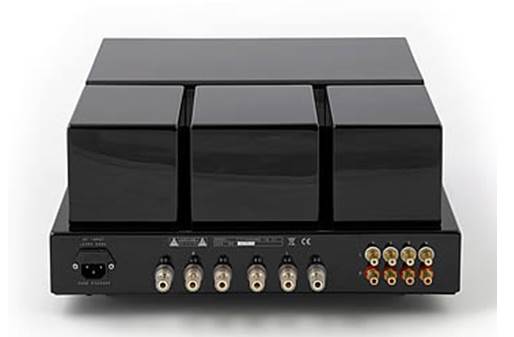
No
chance of confusion here – four line-level inputs on RCA alongside 4mm speaker
sockets/ binding posts optimized for 8ohm and 4ohm loads
Lab report
With a very traditional, auto-biased EL34
push-pull output stage coupled to a pair of very decent transformers, the IA 11
meets its 2x40W/8ohm specification at 1% THD but continues to offer more power
until its true clipping point (closer to 2% in practice here) at 2x64W into
8ohm and 4ohm via the 8 and 4ohm tap, respectively. There’s slightly more juice
available under dynamic conditions at 70W into 8/4ohm loads. This is at least
partially indicated by the IA 11’s very high 9-12ohm output impedance (8ohm
tap) which also largely invalidates its flat ( 0.2dB) 20Hz-10kHz response in practice the system response, and
tonal balance, will largely be determined by the swings in impedance of the
attached loudspeaker. The IA 11 offers low noise (88dB A-wtd S/N ratio, re.
0dBW) and a sensibly limited +32dB gain but, and despite the stepwise
attenuator, channel balance is out by 0.6dB (re. 0dBW) and separation weak at
34dB/20kHz.
0.2dB) 20Hz-10kHz response in practice the system response, and
tonal balance, will largely be determined by the swings in impedance of the
attached loudspeaker. The IA 11 offers low noise (88dB A-wtd S/N ratio, re.
0dBW) and a sensibly limited +32dB gain but, and despite the stepwise
attenuator, channel balance is out by 0.6dB (re. 0dBW) and separation weak at
34dB/20kHz.
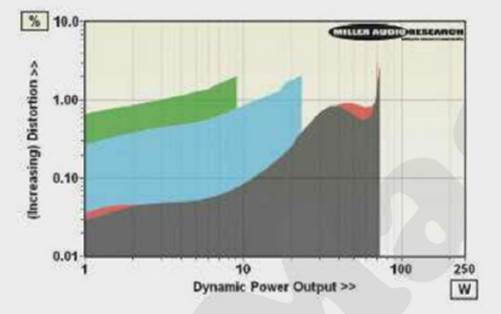
Dynamic
power output versus distortion into 8ohm (black trace), 4ohm (red), 2ohm (blue)
and 1ohm loads (green)
Specifications
·
Power output (<2% THD, 8/4ohm): 64W / 64W
·
Dynamic power (<2% THD, 8/4/2/1ohm): 70W /
70W / 23W / 9W
·
Output impedance (20Hz-20kHz): 9.3-11.5ohm
·
Frequency response (20Hz-20kHz):+0.0dB to
-0.26dB
·
Input sensitivity (for 0dBW/40W): 70mV / 480mV
·
wtd S/N ratio (re. 0dBW/40W): 87.9dB / 103.9dB
·
Distortion (20Hz-20kHz, 10W/8ohm): 0.30-2.4%
·
Power consumption (Idle/Rated o/p): 160W / 280W
·
Dimensions (WHD): 320x200x385mm
Pathos Classic One MK3
The Pathos Classic One MK3 is the only
hybrid amp in this test. It uses a pair of 6922/ECC88 double triode valves in
its input stage, followed by an electronic volume control and a conventional
solid-state amplifier with a Class AB MOSFET output stage rated at 70W. oddly,
some of the Pathos literature describes the output stage as ‘true dual-mono’
although both channels share a single power supply.
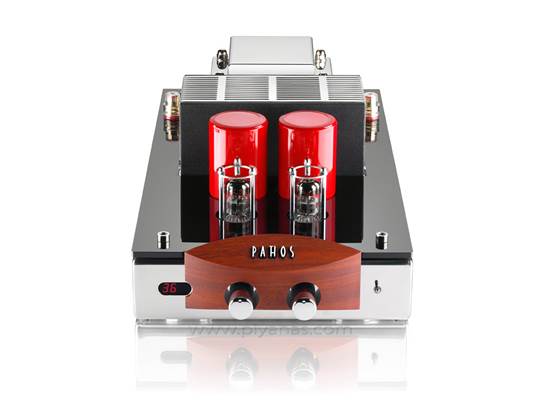
Rotary
encodes govern stepwise volume and input selection. A pair of 6922 Triodes form
the line input stage but the driver stage and power amp are solid-state
In common with many CD players and DACs
that include a low-level valve stage, the 6922s in the Classic One are run at a
very low voltage about one-tenth of a typical all-valve design. This is not a
problem, since the valves are not required to deliver very much actual gain;
instead they are used to color actual gain; instead they are used to color the
sound with ‘warmth, naturalness and musicality’ which is then faithfully
reproduced by the transistor stages.
Source selection and volume control can be
performed either remotely or by the two main knobs which have a center sprung
action, the effects being shown on a two-digit LED display to the left of the
front panel. This model is also the only one on test with a balanced input – a
useful addition if you’ve a high-end CD player or DAC.
Smoothed top end
The Level 42 track showed that the Classic
One Mk3 possesses a firm control over its bass, defining each beat clearly with
an obvious beginning and end. In this single respect of visceral bass ‘clout’,
the Pathos amplifier leads the group. Similarly, percussion revealed a smooth
top end which was well integrated, if a little veiled when compared to the
brighter sounding models in this test such as the Ariand the Unison Research.
The amplifier’s tonal balance was otherwise
impressively even and Katie Melua was aided by a fulsome but neatly ordered
backing. Yet her voice seemed just a little flat amongst it, with graininess
audible around the edges of some of her lyrics. The Mahler benefited from this
same solid low-end precision as the piece closed but the soundstage was less
tactile than with some, seemingly centered in pools around the loudspeakers.
Sound quality: 7.7/10
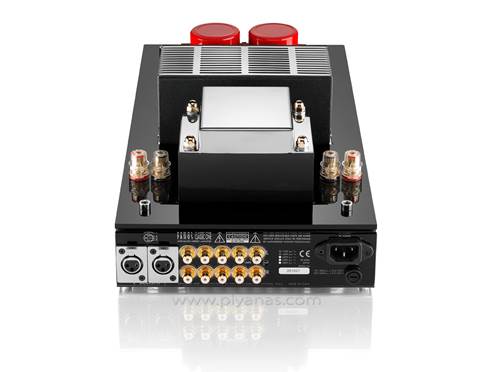
Four
line inputs (one balanced via XLRs) are provided alongside tape in/on and a
single set of 4mm speaker biding posts mounted onto the top plate
Lab report
Combining the ‘warmth’ of valves with the
robustness of a solid-state output stage is the boast of many hybrid amps, even
if there’s some artiface at work. While triode-based preamp stages can be
engineered to offer very low distortion, Pathos has evidently tailored its
design so that the MOSFET power amp faithfully tracks the ‘color’ if the
preceding valves. Distortion, then is still higher than it might be at <0.6%
from 20Hz-20kHz at 10W/80hm but this figure is maintained from a subsonic 5Hz
to an ultrasonic 40kHz – not something you’ll see with a full tube amp unless
it has impossibly low at 0.02ohm through bass and mid, increasing to 0.1ohm at
20kHz, but this does mean the Classic One’s  0.1dB response (20Hz-20kHz) will vary rather less into complex
speaker loads. Finally, the rated 70W power output is just achieved into 8/4ohm
loads but there’s more on tap under dynamic conditions – 135W/4ohm and 200W+
into 2/1ohm.
0.1dB response (20Hz-20kHz) will vary rather less into complex
speaker loads. Finally, the rated 70W power output is just achieved into 8/4ohm
loads but there’s more on tap under dynamic conditions – 135W/4ohm and 200W+
into 2/1ohm.
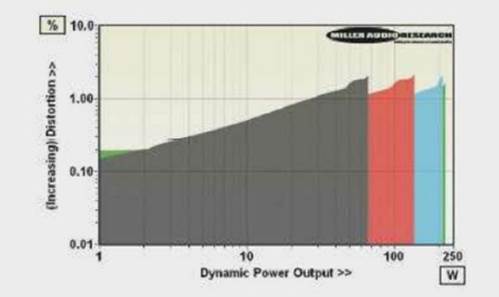
Dynamic
power output versus distortion into 8ohm (black trace), 4ohm (red), 2ohm (blue)
and 1ohm loads (green)
Specifications
·
Power output (<2% THD, 8/4ohm): 73W / ~70W
(protection)
·
Dynamic power (<2% THD, 8/4/2/1ohm): 68W / 135W
/ 212W / 225W
·
Output impedance (20Hz-20kHz): 0.019-0.110ohm
·
Frequency response (20Hz-20kHz):-0.03dB to
-0.12dB
·
Input sensitivity (for 0dBW/70W): 105mV / 910mV
·
wtd S/N ratio (re. 0dBW/70W): 78.1dB / 96.6dB
·
Distortion (20Hz-20kHz, 10W/8ohm): 0.38-0.55%
·
Power consumption (Idle/Rated o/p): 45W / 240W
·
Dimensions (WHD): 150x230x450mm